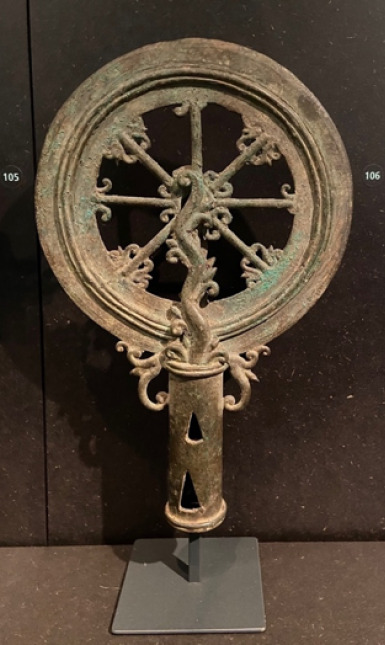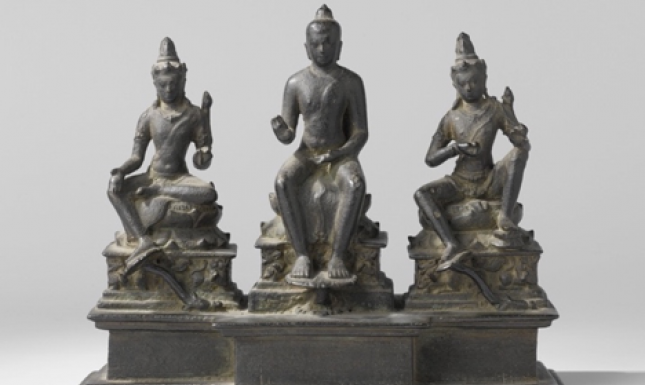Brought to light: Indonesian Bronzes from Rijksmuseum Volkenkunde’s depot
Nearly 300 Indonesian bronze treasures from Rijksmuseum Volkenkunde’s depot are on display. A testimony of merging cultures?
Rijksmuseum Volkenkunde in Leiden has a rich collection of bronze objects from Indonesia. Most of these rest in the museum’s depot, but until the end of this year, almost 300 bronze objects from its depot are on display in the Indonesian wing. These objects, magnificent as they are, were collected when Indonesia was part of the Dutch Colonial Empire, which does raise questions concerning ownership. Currently, several institutions in the Netherlands – such as Nationaal Museum van Wereldculturen (of which Rijksmuseum Volkenkunde is part of) and Rijksmuseum Amsterdam– are collectively researching the provenance of their (colonial) collections, and if restitution is in place. Further research will show if restitution is also necessary for and applicable to these bronzes.

The collection is comprised of Buddhist and Hindu statuettes, but ritual and domestic objects are also on display. Although the majority of these objects is around a thousand years old, they are in a well-preserved state. The reason for that is because they are made of bronze, which is an alloy of copper and tin. The statuettes were cast using the lost-wax technique. Most of these objects were found on the island of Java, which is interesting because copper and tin are rare on Java. Stylistically, some of these objects look Indian.

This is not entirely surprising because the monsoon winds made traveling via the Indian Ocean fast and easy, something the Indonesian have made use of since prehistoric days. Although Indians must have set foot on Indonesian soil, if only temporarily, mainly cultural elements – such as religion and language (Sanskrit and Indian scriptures) – were of importance for the Indonesians, and were probably adopted as kingdoms, such as the Mataram in the 8th century, were being established. This resulted in the creation of some of the greatest architectural examples of Buddhist and Hindu temple complexes, candi, such as the Buddhist Borobudur and the Hindu Loro Jonggrang (Prambanan).

The exhibition displays objects from various categories, such as ‘finials’ – usually adorning the top of a procession staff, but also of hand and temple bells. There is one in the shape of a discus, a type called cakra (figures 1 & 2). Cakras can be seen in both Hindu and Buddhist art. On various relief panels of the Borobudur, the largest Buddhist temple in the world, thought to have been built sometime during the 8th and 9th century, one can see cakras as finials on procession staffs (figure 4).

Indo-Javanese bronze objects are usually thought to be part of an ensemble, but these ensembles are difficult to reconstruct. The smaller statuettes exhibited were probably placed in the niches of temples and monasteries, and in people’s homes for personal worship. It is certain that one of the statuettes on display was part of an ensemble, namely the Bodhisattva Vajrapani from the 9th or 10th century (figure 4). Buddha would have been in the middle, and Bodhisattva Avalokiteshvara on the left. Sadly, most of this ensemble is lost. The Rijksmuseum in Amsterdam has a complete Buddhist triad in their collection (on loan from the Royal Asian Art Society in the Netherlands) from roughly the same age (figure 5). Although Vajrapani is seated in a different position, with one leg pendent (lalitasana), the statuette does gives us an idea of what the complete triad in the Volkenkunde might have looked like.
These bronze objects are the silent witness and proof of the merging and mutual influence of different cultures.

Information about the exhibition on the Rijksmuseum Volkenkunde website: https://www.volkenkunde.nl/nl/zien-en-doen-0/tentoonstellingen/indonesische-bronzen.
Recommended reading and bibliography:
Bernet Kempers, A.J. Ancient Indonesian Art. Amsterdam: C.P.J. Van der Peet, 1959.
Lohuizen-de Leeuw, J.E. van. Indo-Javanese Metalwork. (Bestandskataloge des Linden-Museums Stuttgart).
Stuttgart: Linden-Museum Stuttgart Staatliches Museum für Völkerkunde, 1984.
Lunsingh Scheurleer, P., Klokke, M. J. Divine Bronze: Ancient Indonesian Bronzes from A.D. 600 to 1600. Leiden: E.J. Brill, 1988.
Justus F.C. Schokkenbroek is a first-year student of Art History at Leiden University. His main fields of interest are Asian arts and cultures, particularly from South and Southeast Asia, as well as Early Netherlandish Painting and Italian Renaissance art. Contact: j.f.c.schokkenbroek@umail.leidenuniv.nl.


0 Comments